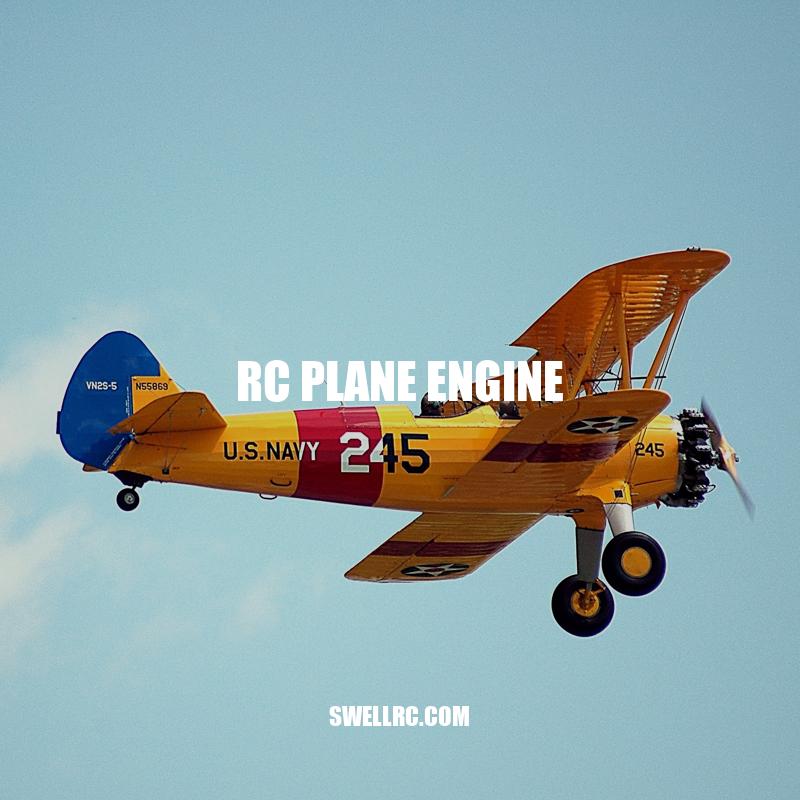Choosing the Right RC Plane Engine: A Guide to Types, Parts and Factors
An RC plane engine is an essential component that powers the radio-controlled model aircraft. The engine generates power that moves the propeller or rotor, which propels the plane forward and keeps it in flight. RC plane engines come in different types, sizes, and power output levels, depending on the plane’s weight, wingspan, and desired performance. Choosing the right engine for your model aircraft can significantly influence its performance and flying experience. Some factors to consider when selecting an RC plane engine include engine size, power output, fuel type, and the type of aircraft you need to fly. Novice pilots might prefer electric engines, while experienced pilots may choose gas-powered engines to match their flying style and aircraft type. In this article, we will explore the different types of RC plane engines, the key components, and the crucial factors to consider when choosing the right engine for your model airplane.
Types of RC Plane Engines
RC plane engines fall into two primary categories, electric and gas-powered. Each engine type has its advantages and disadvantages, depending on the aircraft type, flight conditions, and pilot experience level. Here are some details on each engine type:
- Electric engines:
- Lightweight and quiet
- Easy to maintain
- No messy oil or fuel required
- Good for beginners and small planes with minimal power needs
- Gas-powered engines:
- More powerful, providing a more exciting flying experience
- Provide a more authentic plane-flying experience
- Preferred by experienced pilots for larger and more complex planes
- Require a wet lubrication system to prevent engine wear
When choosing the right RC plane engine for your model aircraft, you need to consider the aircraft type, your flying style, and experience level. Online resources such as websites and forums can provide detailed information and reviews of different engine types and specifications. Alternatively, you can also check online stores that offer various engines, including electric and gas-powered ones, such as Horizon Hobby or Tower Hobbies. Next, we will explore the primary components of an RC plane engine and their functions.
What are the two main types of airplane engines?
There are two main types of aircraft engines: jet and reciprocating. Jet engines are commonly used in commercial airplanes because of their speed and power, while reciprocating engines are typically used in smaller, personal aircraft. For more information about aircraft engines, you can check out aviation websites such as AOPA or aviation product websites such as Aircraft Spruce.
An RC plane engine consists of several parts that work together to provide power to the aircraft. Here are some of the key components of a typical RC plane engine:
| Component | Function |
|---|---|
| Cylinder | Compresses the fuel-air mixture and initiates combustion to generate power. |
| Carburetor | Blends air and fuel in the correct proportion and sends it to the cylinder for combustion. |
| Piston | Moves up and down inside the cylinder to compress the fuel-air mixture and generate power. |
| Crankshaft | Converts the linear motion of the piston into rotational movement that powers the propeller. |
| Exhaust system | Channels the burnt fuel-air mixture away from the engine and the aircraft. |
An interesting fact about the cylinder is that it typically comes in different configurations, including single-cylinder, twin-cylinder, and multi-cylinder versions. Single-cylinder engines are ideal for small planes, while multi-cylinder engines are more appropriate for large and fast planes.
It is worth noting that some components, such as the carburetor and exhaust system, require proper tuning and maintenance to ensure optimal engine performance and longevity. If you are unsure how to tune and maintain your RC plane engine, online resources such as tutorials and forums can provide helpful guidance. You can also find engine tuning and maintenance tools and products from online stores such as Amazon and Alibaba.
How does an RC airplane engine work?
An RC airplane engine works similarly to a full-scale airplane engine. The principle of how model turbine engines work is simple – they take in air and compress it, add fuel to the compressed air, ignite the mixture, and then release it through the exhaust nozzle. This process creates thrust and propels the airplane forward. For those interested in purchasing RC airplane engines or learning more about their operation, websites such as Horizon Hobby and RCPlanet.com offer a variety of options and resources.
RC planes use two primary types of engines: electric and gas. Here are some of the key differences between the two types:
Electric Engines:
- Lightweight and easy to mount on the aircraft.
- Quiet and relatively less polluting than gas engines.
- Require minimal maintenance and tuning.
- Provide a smooth and predictable power output.
- Suitable for beginners and small planes that don’t require much power.
Gas Engines:
- More powerful and provide a thrilling flying experience.
- Create a realistic engine sound and smell, adding to the excitement.
- Require regular tuning and maintenance to ensure optimal performance.
- Suitable for more experienced pilots and larger planes that require more power.
- Use gasoline or other gas-based fuels that may generate more pollution than electric engines.
It is important to choose the right type of engine that matches your aircraft’s size and power requirements. You can find a wide variety of electric and gas engines online and offline, with prices ranging from a few dollars to several hundred dollars, depending on the brand, power output, and features.
If you are new to RC planes, it may be helpful to consult online resources such as RC plane forums, tutorials, and reviews to learn about the various engine options and their pros and cons. Websites such as Horizon Hobby, RC Planet, and Banggood offer a wide range of RC plane engines and related accessories that you can browse and purchase online.
What type of engines are used by airplanes?
Aircraft engines, also known as aero engines, can be either piston engines or gas turbines. Some aircraft engines have been powered by rockets, and electric motors are becoming more common in small UAVs. More information about airplane engines can be found on aviation websites such as AOPA or FAA.
Factors to Consider when Choosing an RC Plane Engine
When selecting an RC plane engine, there are different factors that you need to consider. Here are some of the most important:
Engine Size and Power
- The engine should match the size and weight of your plane. An undersized or oversized engine can harm the plane’s performance and safety.
- The engine’s power output should match your desired flight style and conditions, such as speed, altitude, aerobatics, or endurance.
- The engine’s fuel consumption rate and tank capacity should be adequate for your flight time and range.
Fuel Type
- Electric engines use rechargeable batteries that are easy to maintain and eco-friendly.
- Gas engines use gasoline, kerosene, or other fuels that require specific storage, handling, and disposal procedures.
- Some gas engines can also run on a mixture of gasoline and oil (two-stroke engines) or use a separate oil pump (four-stroke engines).
Aircraft Type and Experience Level
- The engine should match your aircraft type, such as a trainer, sport, scale, or aerobatic plane.
- Your experience level and flying goals should inform your choice of engine power and handling characteristics.
- A higher-powered engine may require more skill and practice to handle, while a lower-powered engine may limit your flying options.
You can consult the RC plane manufacturer’s specifications, online forums, and hobby stores to find the suitable engine for your aircraft and needs. Some popular RC plane engine brands include OS Engines, Saito Engines, SuperTigre, and E-flite. You can also find engine accessories such as propellers, mufflers, glow plugs, and fuel lines that can enhance your engine’s performance and lifespan.
How to choose a motor for RC plane?
When choosing a motor for your RC plane, it is important to consider the kv (RPM per volt) rating and the size of the motor. A higher kv and a smaller propeller will result in a faster plane. For beginners, a motor with a kv rating between 850 and 1500 is recommended. Additionally, consider the size of the motor and ensure it fits the RC plane. Some popular websites for purchasing RC plane motors include HobbyKing and Amazon.
Final Thoughts
Choosing the right RC plane engine is a critical decision that can impact your flying experience and safety. While there are different engine types, sizes, and power outputs to choose from, taking the time to consider your aircraft type, fuel type, and experience level can help you find the best match. You should also pay attention to the engine’s cylinder, carburetor, and accessories, as well as its maintenance requirements, warranty, and customer service. Investing in a quality RC plane engine can lead to countless hours of fun and learning in the world of radio-controlled aviation. Whether you are a beginner or an advanced pilot, having a reliable and well-performing engine can make all the difference in reaching your flying goals.



